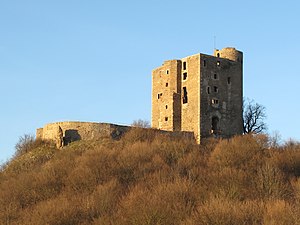Arnstein Castle
| Arnstein Castle | ||
|---|---|---|
|
Arnstein Castle |
||
| Creation time : | around 1130 | |
| Castle type : | Hilltop castle | |
| Conservation status: | Palas, keep | |
| Standing position : | Nobles, counts | |
| Place: | Sylda - Harkerode | |
| Geographical location | 51 ° 41 '3.9 " N , 11 ° 24' 38.7" E | |
| Height: | 210 m above sea level NN | |
|
|
||
The castle Arnstein is the ruins of a hilltop castle on the edge of the resin and is located in Mansfeld-Südharz in Saxony-Anhalt . The ruin stands at 210 m above sea level. NN high elevation between the places Sylda and Harkerode south of Aschersleben and northwest of Hettstedt . The castle of the Lords of Arnstein with its impressive, tower-like palace building that can be seen from afar emerged from the medieval fortifications in the 12th century. It has been known nationwide as a romantic ruin since the 19th century .
history
The medieval castle was the ancestral seat of the Lords of Arnstein . These came from the Swabian family of the Lords of St (r) eusslingen. Walther II named himself after the castle in 1156, this was the first documentary mention. The first Romanesque castle must have been built during this time. The two eastern round towers and the curtain wall between them can be assigned to this construction phase . No other buildings from the Romanesque period have yet been found.
Walther III. von Arnstein was connected to the Ascanians and Wettins through marriage . This made the Arnsteiners one of the greats of the Saxon nobility. They were able to own large properties in the Harz foreland. Around 1294 Walther IX. into the Teutonic Order . He handed over his property to his brother-in-law Otto von Falkenstein , who had the castle administered by bailiffs . With the extinction of the Falkensteiner in 1334, the rule fell to the Counts of Regenstein , who sold them to the Counts of Mansfeld in 1387 . When the Mansfeld inheritance was divided in 1420, the castle came to the Mansfeld-Vorderort line. The construction of the Gothic residential tower-like hall building is to be scheduled for around 1400 (cf. Burgk , Ziegenrück , Kapellendorf ). In its original form it had four floors.
In 1442 the Counts of Mansfeld had to recognize the feudal sovereignty of the Saxon elector for the Arnstein rule . They were enfeoffed in 1486 by Duke Albrecht of Saxony with Arnstein Castle, together with half of Morungen Castle and the rule of Heldrungen .
After it was destroyed in the Peasants' War , Count Hoyer IV rebuilt the castle around 1530. The north-eastern circular wall tower was demolished and the middle house built.
In 1563, Johann Albrecht , founder of the Mansfeld-Vorderort-Arnstein line, had the castle further expanded so that it was called a castle . The Palas was increased by two bullets and completely rebuilt the castle church and the kitchen house. The central and gatehouse were also rebuilt . The still partially preserved spiral stones were created.
After the Arnstein line of the house Mansfeld-Vorderort expired in 1615, the castle was used as a residential palace by the Mansfeld-Vorderort line until 1637. In inventories of the 17th and 18th centuries, the need for repairs to the buildings was repeatedly lamented, and in 1723 a report to the Elector of Saxony wrote that it was "everywhere in ruinous condition". By tenants who used the castle grounds economically, makeshift repairs were repeatedly carried out, but these did not prevent many buildings from deteriorating further.
In 1780 the last members of the Count's line died and the rule fell to Electoral Saxony and in 1815 to the Kingdom of Prussia .
In the middle of the 19th century, the castle began to attract greater attention as a monument. The owners, the Freiherren Knigge , took security measures and initiated a touristic development. Further repairs were carried out until the 1930s. A homeland association has been safeguarding the ruins since 1992.
The thesis put forward by Hermann Wäscher and Helmut Wolf that the Romanesque castle was a fort with four corner towers is rather unlikely.
location
Use the A14 motorway to the Könnern exit . Continue to Hettstedt on the federal road . Orientate in Hettstedt towards Harzgerode . After 5 km turn onto the country road to Ritterode . The castle can be reached after another 5 km via Ritterode, Willerode and Sylda . From the parking lot, a footpath leads left along the castle hill to the castle.
Backdrop
The area around the castle was used as a motif in the 1970 television film "Der Panzerkommandant", directed by Ursula Schmenger .
The castle complex served as the backdrop for the 1975 film adaptation of Till Eulenspiegel by Rainer Simon with Winfried Glatzeder in the lead role.
In 2009, some scenes from the British film Black Death were shot below the ruins .
swell
- Reinhard Schmitt : On the history and building history of Arnstein Castle, Mansfelder Land district. In: Castles and palaces in Saxony-Anhalt . 10/2001, pp. 33-135.
- Reinhard Schmitt: Arnstein Castle, Ldkr. Mansfelder Land. An addendum. In: Castles and palaces in Saxony-Anhalt. 11/2002, pp. 195-198.
Web links
- History of Arnstein Castle
- Reconstruction drawing in the medieval state
- Material on Arnstein Castle ( Memento from June 12, 2007 in the Internet Archive ) in the Duncker Collection of the Central and State Library Berlin (PDF; 182 kB).
- Arnstein Castle from the northwest, around 1890



